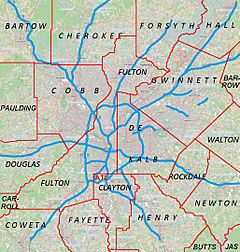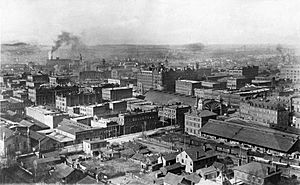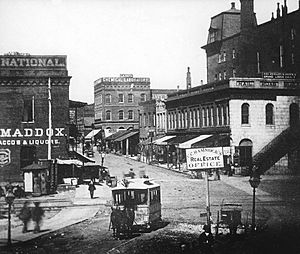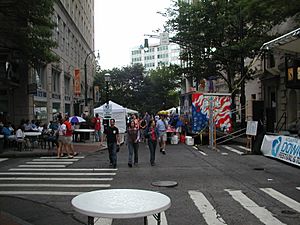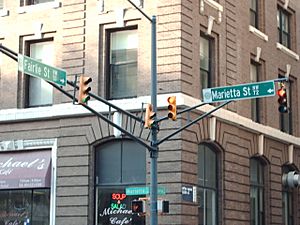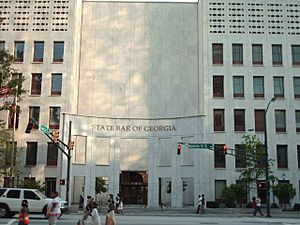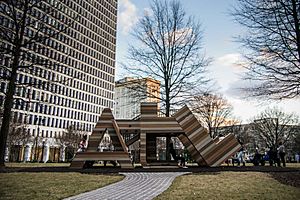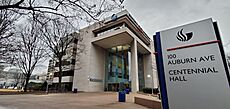Downtown Atlanta facts for kids
Quick facts for kids
Downtown Atlanta
|
|
|---|---|

Part of the Downtown Atlanta skyline
|
|
| Country | United States |
| State | Georgia |
| City | Atlanta |
| Area | |
| • Total | 4.00 sq mi (10.4 km2) |
| Elevation | 738-1,050 ft (225-320 m) |
| Population
(2017)
|
|
| • Total | 26,850 |
| • Density | 6,680/sq mi (2,581/km2) |
| Time zone | UTC-5 (EST) |
| • Summer (DST) | UTC-4 (EDT) |
| Website | https://www.atlantadowntown.com/ |
Downtown Atlanta is the main business area of Atlanta, Georgia, in the United States. It's the biggest of Atlanta's three main commercial areas. The others are Midtown and Buckhead.
Downtown Atlanta is home to many company offices and government buildings. You'll also find Georgia State University, sports stadiums, and most of Atlanta's fun tourist spots here. It covers about four square miles and had around 26,850 people living there in 2017. Like other city centers, Downtown Atlanta has been changing. New homes and businesses have arrived, and old buildings have been updated.
Contents
Exploring Downtown Atlanta's Location
Downtown Atlanta is bordered by North Avenue to the north. To the east, you'll find Boulevard. Interstate 20 marks its southern edge, and Northside Drive is to the west. This area includes well-known spots like Five Points and the Hotel District. It also has neighborhoods such as SoNo and Castleberry Hill.
A group called the Atlanta Downtown Improvement District (ADID) uses a smaller definition. Their area is about one and two-tenths square miles. It's generally bordered by North Avenue, Piedmont Avenue, and the Downtown Connector. This smaller area focuses on the core business parts of Downtown.
A Look Back: Downtown Atlanta's History
Downtown Atlanta's story began in 1826. People were looking for a good route for a canal. In 1833, Governor Wilson Lumpkin asked for three railroad lines to be built. By 1836, the state-funded Western and Atlantic Railroad was approved. This railroad connected central Georgia to states north and west.
Because of the railroad, a town called Terminus was founded in 1837. It was named "Terminus" because it was the end of the rail line. In 1842, the town's 30 residents changed its name to Marthasville. This honored Governor Lumpkin's daughter.
In 1845, a railroad engineer suggested changing Marthasville's name. The first idea was "Atlantica-Pacifica," which was shortened to "Atlanta." In 1847, Atlanta officially became a city. Its limits stretched one mile from the railroad depot.
Atlanta During the Civil War
By the time the Civil War started, Atlanta was a major railroad and manufacturing center. This made it a target for the Union Army. In 1864, General William T. Sherman burned Atlanta during his March to the Sea. Atlanta was the only major American city to be destroyed by war.
Atlanta quickly began to rebuild after the war. In 1868, Georgia's state capital moved to Atlanta from Milledgeville. By the 1920s, a busy downtown business area had grown, surrounded by places where people lived.
Sports and Growth in Downtown
Professional sports came to Atlanta in 1965. The Braves baseball team moved here from Milwaukee. The National Football League added the Falcons football team in 1966. The Hawks basketball team arrived in 1968. Today, the Falcons and Hawks still play their home games downtown.
Business grew a lot in the 1970s. This led to new buildings in Downtown, especially in Peachtree Center and the Hotel District. The city's main business area shifted north along Peachtree Street. This was even after the MARTA central station opened there in 1975. By the mid-1980s, Peachtree Center became a key area for hotels and conventions.
In 1990, parts of Downtown, like Five Points, seemed empty. The area was mostly busy during the day with office workers and students.
A New Beginning: The Olympics and Beyond
The 1996 Olympic Games helped Downtown Atlanta bounce back. Georgia State University also changed from a school for commuters to a traditional college. These two things started a new period of growth for Downtown.
The Olympics led to the creation of Centennial Olympic Park. This park was built as a lasting memory of the games. In the years that followed, the park helped create a tourist area. This area now includes the World of Coca-Cola, the Georgia Aquarium, the CNN Center, and other attractions.
After the 1996 games, Georgia State University's president, Carl Patton, had a vision. He wanted the university to be a true part of the city. This plan, called the Main Street Master Plan, has brought billions of dollars in new construction. This has boosted Downtown's economy and population.
On March 14, 2008, a strong tornado hit Downtown. It caused damage to several famous buildings and stadiums. This was the first tornado to hit Downtown since records began in the 1880s. Many people were hurt, but only one person died.
Downtown Atlanta's Look and Feel
Downtown Atlanta has some of the city's tallest buildings. The Bank of America Plaza building is the tallest in Atlanta. It stands between Midtown and Downtown. At 1023 feet (312 meters), it's also the tallest building in any U.S. state capital. It's one of the tallest buildings in the United States outside of New York City and Chicago.
Downtown is the biggest of Atlanta's three business areas. It features amazing buildings, some dating back to the 1800s. Some well-known tall buildings in Downtown include:
- Westin Peachtree Plaza
- Georgia-Pacific Tower
- Flatiron Building
- SunTrust Plaza
- 191 Peachtree Tower
- Centennial Tower
- Equitable Building
- Healey Building
- Bank of America Plaza (Atlanta)
- Candler Building (Atlanta)
- Hurt Building
Downtown Neighborhoods
Downtown is split into nine smaller areas:
- Castleberry Hill
- Centennial Hill
- Fairlie-Poplar
- Five Points
- Hotel District
- Luckie Marietta
- Peachtree Center
- SoNo (south of North Avenue)
- South Downtown
What Drives Downtown's Economy?
Downtown has a lot of office space, over 26 million square feet. When combined with Midtown, it's more than many other big cities. Downtown's economy also gets a boost from its government buildings, event venues, and shops.
Government Buildings
The U.S. government has a strong presence in Downtown. The U.S. Census Bureau has offices here. The National Transportation Safety Board also has an office in Downtown Atlanta. The Martin Luther King Jr. Federal Building was built for the growing Postal Service.
The Sam Nunn Atlanta Federal Center is the ninth largest federal building in the U.S. It's the biggest in the Southeast. It houses 5,000 employees from many federal agencies. The Richard B. Russell Federal Building holds the U.S. District Court and other federal offices.
Further north is the U.S. Court of Appeals. This court handles federal cases from Alabama, Georgia, and Florida. It's named after a former Chief Judge, Elbert P. Tuttle.
Downtown also has state, county, and city government buildings. The Georgia State Capitol, where Georgia's government meets, is in South Downtown. Its gold dome can be seen from the Downtown Connector. The Fulton County Government Center and Courthouse are also located here.
Sports and Event Venues
Downtown is home to most of Atlanta's major sports venues. Mercedes-Benz Stadium is where the Atlanta Falcons (NFL) and Atlanta United FC (MLS) play. This stadium also hosts big college football games. Nearby is State Farm Arena, home to the Atlanta Hawks (NBA).
Just south of Interstate 20 are Georgia State University's baseball, basketball, and football stadiums. The football stadium was once part of the Olympic Stadium.
The Tabernacle on Luckie Street is a music concert hall. It was built in 1910 as a church. In 1996, it became a House of Blues Club for the Olympics. It was renamed "The Tabernacle" in 1998. This concert hall has four floors and can hold 2600 people.
AmericasMart is a huge trade center with four buildings. It hosts many trade shows each year. Some showrooms are open daily, while others are open during special events.
The Georgia World Congress Center is a large convention center. It's near Mercedes-Benz Stadium and the CNN Center. Opened in 1976, it was the first state-owned convention center in the U.S. It's the fourth largest in the country. Over a million people attend conventions here every year.
Shopping and Entertainment
Underground Atlanta is Downtown's shopping and entertainment area. It's located near the MARTA Five Points Station. In the 1920s, streets were built above the ground here. Below these elevated streets, you'll find shops, restaurants, and nightclubs.
The Mall at Peachtree Center is on Peachtree Street. It has 60 specialty shops, restaurants, and a food court. It also includes a large athletic club. You can get there easily using MARTA's Peachtree Center station.
Centennial Yards is a huge new project. This $5 billion development will bring more restaurants, entertainment, homes, hotels, and shops to Downtown. It's expected to be finished in 2026.
Parks in Downtown Atlanta
Woodruff Park, named after Robert W. Woodruff, is a 6-acre park in Downtown. It's located near Five Points. The park is home to the famous Phoenix Memorial. This statue reminds people of Atlanta's rebirth after the Civil War.
Centennial Olympic Park is a 21-acre park built for the 1996 Olympic Games. It's the largest downtown park built in the U.S. in the last 25 years. A famous part of the park is the Fountain of Rings. It's the world's largest interactive fountain using the Olympic symbol. The park hosts many events, including concerts and fireworks on Independence Day. Hurt Park is another park with a lighted fountain.
Fun Attractions to Visit
Just north of Centennial Olympic Park is the Georgia Aquarium. It's the largest aquarium in the United States. It holds more than 8 million gallons of water. The Georgia Aquarium is listed as one of the "1,000 Places to See Before You Die."
The World of Coca-Cola is located near the Georgia Aquarium. It's a museum dedicated to the history of Coca-Cola. Downtown is also planning new attractions, especially around Centennial Olympic Park.
Learning in Downtown Atlanta
Georgia State University is a big public research university. It has played a major role in Downtown's recent growth. The university has been building and buying land as it changes from a commuter school to a traditional university.
In the early 2000s, the university created a master plan. The goal was to make Georgia State "a part of the city, not apart from the city." This plan has led to many new or renovated university buildings. These include classrooms, dorms, dining halls, and sports facilities. This has helped make Downtown a lively place, especially around Woodruff Park and Sweet Auburn.
Downtown Atlanta is part of the Atlanta Public Schools system. Local schools include Centennial Place Academy (K-8) and Midtown High School.
Getting Around Downtown
Downtown is a major transportation hub for the whole region. The Downtown Connector runs north and south through the area. This is the city's main freeway. Downtown is also served by Interstate 20, which forms its southern border. Many surface streets also offer ways to get around.
The MARTA subway lines meet in the middle of Downtown at the Five Points station. The North-South Line has other stops at Garnett, Peachtree Center, and Civic Center. The East-West line has stops at Dome/GWCC/Philips Arena/CNN Center and Georgia State.


